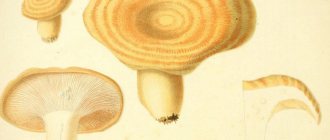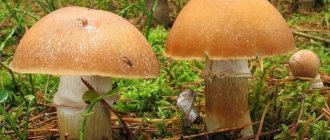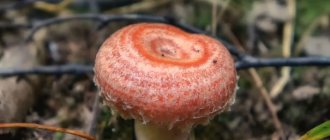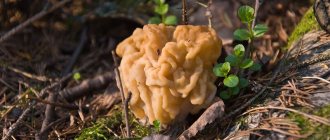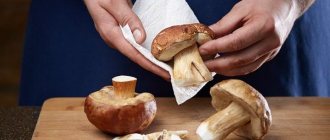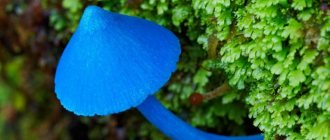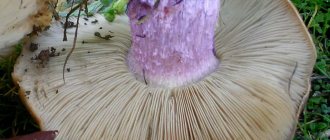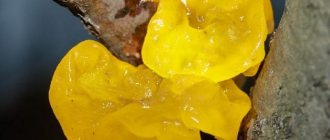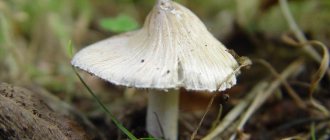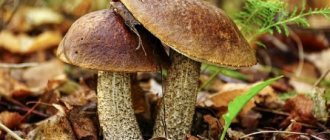Short description
| Type of mushrooms: | Edible |
| Other names (synonyms): | Agaricus torminosus, Volyanka, Volnukha, Broth |
| Latin name: | Lactarius torminosus |
| Family: | Russulaceae (Russulaceae). |
| Distinctive feature: | Pink jackfruit - valued for its peppery flavor and eaten after proper preparation, but be careful, this species is very irritating to the digestive system when eaten raw. |
| Beginning of the season: | July |
| End of season: | October |
| Leg height (cm): | 2-6 cm |
| Cap width (cm): | 5-15 cm |
| Smell: | spicy |
| Taste: | bitter, caustic |
| Tasting score: | [kkstarratings] Have you tried this mushroom? Then rate it! |
| Hat: | initially hemispherical to convex, and when the mushroom ripens, a depression is formed in the center and the edges rise until it takes the shape of a shallow funnel. The edge of the cap is strongly curled inward. The skin is covered with a thick layer of hairs, forming veils, which decreases with age and eventually the hairs are worn off, leaving the surface more or less smooth. The color is pinkish-orange to pale dull pink, later becoming orange to whitish towards the edges as the pink gradually fades. |
| Leg: | cylindrical, hard when the mushroom is young, later it becomes hollow and smooth. Pale red to pinkish-brownish, brighter towards the base. |
| Hymenophore (bottom of cap): | the plates are pink, jagged and widely folded, sometimes forked, the ribs are smooth. |
| Disputes: | elliptical with ornament, 6.7-8.8 (9.4) x 5.5-6.7 (7.2) microns. |
| Pulp: | white, dense and fragile, becoming flaccid with age. |
| Natural environment and mycorrhiza: | grows together with birch in mixed forests. It is also known to grow in urban environments when birch trees are nearby. |
| False doubles: | Lactarius spinosulus is easily distinguished by the non-hairy edge of the cap. The white moth (Lactarius pubescens) is distinguished by an almost white cap and smaller size. |
| Growing: | – |
| Use: | just salt it after soaking it in water for 2-3 days or boiling it for 15-20 minutes. Almost all mushrooms can be eaten only after 35 - 40 days of cold pickling. |
| Medicinal properties: | – |
| Spreading: | everywhere, mainly in the northern part of the forest zone. |
Volnushki are not very popular in other countries, but they are in demand among mushroom pickers in Russia. This is a conditionally edible mushroom, it belongs to class 2 in terms of nutritional and taste qualities. Find out how to correctly identify red mushrooms in the forest, how to cook them or store them for future use, and what to do to prevent the fruits from becoming bitter.
Description and characteristics of edible mushroom
A number of mushrooms belong to the group of mushrooms; there are many varieties of them. Pink volnushka has other popular names: volnyanka, volnovukha, volzhanka, volvenka, volvyanitsa, volminka, rubella, krasulya, decoction. In scientific language, it received this name - Lactárius torminósus.
The cap grows in diameter from 4 to 12 centimeters; in young fungi it is convex, becoming flat as it grows. In the center there is an umbilical cavity (funnel), the edges of the cap are lowered. The skin is slightly slimy and has coarse fibers arranged in uneven circles.
The color of the hat is gray-pink or pinkish, and may darken when pressed. If the fruit body grows in dry places, then the color of the cap turns pale and fades.
The pulp when cut is dense, strong, snow-white. The taste is spicy. The milky juice is also white, sharp, and is released very abundantly when the mushroom is broken.
The hymenophore (bottom layer of the cap) is a whitish plate with a pink tint, which turns yellow over time. They are not wide, often located, descending along the leg. Between them there are intermediate plates. The spore powder is creamy white or white in color.
The leg is cylindrical, strong, hard, tapering towards the base. In young fruiting bodies it is solid, but becomes hollow with age. The color is pale pink, the surface is covered with fluff and small pits.
Useful properties and contraindications
Compound
The composition of the waves includes:
- proteins (3%),
- fats (0.5%),
- carbohydrates (1.7%),
- dietary fiber (5.5%)
- water (89%).
In turn, fats contain organic acids, including lactic, acetic and oleic. Carbohydrates are found in fibers mainly as fiber, which contains chitin. When it enters the human body, chitin binds lipids and prevents the absorption of fats. As a result, cholesterol levels become lower. But chitin can cause allergies in those who react to shellfish, and can even make it harder to digest food, even blocking the digestive system. Therefore, despite the fact that chitin is beneficial for the human body, people with gastrointestinal problems should be wary of consuming it. Volnushki are rich in vitamins such as: A, B1, B2, E, C, PP, etc. These mushrooms contain eighteen types of amino acids, as well as biologically active substances, glutamic and aspartic acids.
Despite the fact that the calorie content of volnushki is only 22 kcal per 100 g, they quickly satisfy hunger and give a feeling of fullness, which is why their consumption helps fight excess weight. In patients with diabetes, glucose levels are stabilized, cholesterol is reduced, and blood vessels are cleansed and strengthened. Biologically active substances found in volnushki help improve the condition of the skin and hair, and also help strengthen the immune system. In addition, heart rate and blood pressure normalize, and blood flow improves. Regular consumption of volushki helps improve brain function, correct vision problems, has a good effect on blood vessels, joints, and the nervous system, and can prevent the development of hypertension and even oncology.
But if you neglect the pre-treatment of these mushrooms, you can easily get food poisoning with consequences in the form of nausea, dizziness, etc.
Growing at home and in the country
It is quite possible to grow pink volnushki at home or in a summer cottage. It makes sense to plant and cultivate these mushrooms closer to autumn. To do this you will need to do the following:
- Find overripe, mature fruits in the forest, cut them into pieces, and dry them in the shade for 24 hours.
- Prepare the planting site: dig up the soil and add organic fertilizer to it.
- Make furrows and sow volyanka.
- Mulch the beds with straw or dry leaves, sawdust.
There is another way to breed rubella:
- Adult, overripe fruits should be cut into thin slices, placed in a basin and filled with warm water.
- The contents of the container should be stirred several times a day with a wooden stick.
- After 24 minutes, you need to water the place where you plan to sow mushrooms with this mixture.
- Mulch the planting.
Note! If weeds appear in the bed with the mushrooms, they must be removed manually so as not to disturb the mycelium.
The first harvest of Volyanka is not collected; it is left to ripen. And from next year, mushrooms can only be removed by cutting, without picking. The yield of reds is once a year.
Preparation
Since the mushroom is conditionally edible, it is most often prepared by pickling or pickling. However, first you need to boil the volushka and be sure to drain the first water. If the mushroom is not cooked enough, it can cause intestinal disorders.
Mushrooms should be soaked for a long time (about a day) to remove the bitterness. Salted volushki will be ready only a month and a half after preparation.
Krasulya.
- In Europe, these mushrooms are not considered edible, but not everywhere. For example, in Finland they are eaten fried, after boiling them for about 10 minutes, and after blanching they are also eaten in Sweden. But French and Italian gourmets consider them poisonous. The same applies to the Czech Republic and Poland.
- Volnushki strengthen health and immunity, fight harmful microorganisms and are useful. However, these properties are lost if they are overcooked.
- A knowledgeable mushroom picker will go looking for trumpets in the northern part of the forest.
- The advantage of the mushroom is its pile and cap, which is easy to clean, but the disadvantage is that worms love it, despite the bitterness, so it is better to collect very young mushrooms.
Similarities with false doubles
The pink wave has no false counterparts, but there are species that are very similar to the wave. You can distinguish them in the photo or use the table:
| Differences | Milky gray-pink | Ryzhik |
| Appearance | The cap can be of different colors: from amber yellow to copper red. At an early age it is more pink, shiny, and has a flat shape. Over time, the edges of the cap rise. The color of the cap and legs are identical. | The hat is of calm shades with a predominance of orange, almost always smooth. |
| Places of growth | Mixed and deciduous forests | Spruce and pine forests grow on a bed of pine needles. |
| Vivid Features | When you press the cap, a watery white juice is released. A pungent odor is a characteristic difference between an edible species and an inedible one. | Bright orange color when broken. The mushroom turns dark brown after boiling. |
False waves
Doppelgangers are called milkmen that look similar to them. The cap of the milkweed, like that of the moth, is pinkish in color, may have reddish rings, but is completely without edging around the edges. This mushroom is much smaller, so it is not so juicy, and it is inferior in taste to the mushroom.
Edible doppelgängers
Common milkweed
Common milkweed (Lactarius trivialis)
Common milkweed - even in dry weather the cap is shiny and the rings are present. The young mushroom has a dove-gray, convex cap; old mushroom - the cap is brown or purple, later it becomes ocher or yellow and becomes flatter. The edges are slightly wavy, rolled inward; the stem has a cylindrical shape of a grayish or yellowish color. The milky juice becomes slightly greenish when cut.
Faded milky
Lactarius vietus
Milky is faded - the cap changes from lilac to white or gray with a slight convexity with a slightly depressed center, darker than the edges. The leg is smooth and slightly curved, much lighter than the cap.
Brownish milkweed
Brown milkweed (Lactarius fuliginosus)
Milky is brownish - the cap is velvety, its color is brown or dark chocolate, the shape changes from convex to depressed as the mushroom grows. The flesh turns slightly pink when broken and gives off a fruity aroma.
Milky brown
Brown milkweed (Lactarius lignyotus)
Milky brown - has a velvety dark chestnut or brown, almost black, cap with a convex tubercle, which then disappears and a depression appears. There is a fringe on the wavy edges. The stem is cylindrical and almost always has the same color as the cap. The milky juice is not thick, and there is no causticity in it.
Milky hygrophoroid
Lactarius hygrophoroides
Milky hygrophoroid - a dry cap of a brownish color, sometimes has a brown or reddish tint, with a slight convexity, which then disappears, and the cap becomes depressed. The mushroom is very fragile with white flesh.
Milky-hot milky
Stinging milkweed (Lactarius pyrogalus)
Milky-milky - the cap is moist, slimy, round in the center with a tubercle, later, on the contrary, concave. The pulp is light gray in color, quite dense with a pleasant mushroom aroma, and has a burning taste, which is why the mushroom is called that.
Inedible twins of tremors
Milky spiny
Spiny milkweed (Lactarius spinosulus)
Milky spiky - the color of the cap changes from pink to red-brown; small red scales may be present. The pulp is ocher or white, sometimes closer to green, there is no smell, the taste is very pungent.
Milky sticky
Sticky milkweed (Lactarius blennius)
The sticky milkweed has a gray-green cap with dark spots. The center is darker than the edges. The leg is sticky to the touch, lighter than the cap. The pulp is white, practically odorless, and has a hot, peppery taste. The milky juice is sticky and turns green or olive when broken.
Milky liver
Liver milkweed (Lactarius hepaticus)
Milky liver - a very smooth cap has the shape of a funnel, brown in color with the addition of olive. The pulp is brittle, light brown in color, extremely caustic. The milky sap turns yellow when exposed to air.
How to prepare volushki for the winter
Due to the fact that the juice contained in the pulp is bitter, the mushrooms are soaked before cooking for 24 hours, and the water is drained 3-4 times. After this, they are boiled for 15-20 minutes, the water is drained and boiled again.
Most often, volushki are pickled or salted. And although the mushrooms change color during the process, becoming grey-gray, their taste is very pleasant.
Pickled
Ingredients for 1 kg of mushrooms:
- sugar – 2 teaspoons;
- salt – 1 tbsp. spoon;
- vinegar - 1 tbsp. spoon;
- 2 bay leaves;
- peppercorns – ½ teaspoon;
- cloves – 4-5 pcs.;
- 1 onion and 1 carrot each.
Preparation:
- For 24 hours, the mushrooms are soaked in water with salt and citric acid (the proportion per 1 liter of water is 10 g of salt and 2 g of lemon). The water needs to be changed 3 times.
- Boil for 10 minutes over low heat.
- To prepare the marinade, place sugar, salt, spices and chopped vegetables in a saucepan with water, cook for 15 minutes, then add mushrooms and vinegar.
- Boil for another 15-20 minutes over low heat, stirring occasionally.
- Place in jars, fill with brine and roll up.
Watch the video! Pickled trumpets
Cold salted
For 1 kg of mushrooms you will need:
- salt – 50 g;
- citric acid – 2 g;
- water – 1 l;
- spices and seasonings to taste.
Preparation:
- The mushrooms are soaked for 24 hours, changing the water every 8 hours (you need to add 10 g of salt and 2 g of citric acid per 1 liter of water). After this, rinse with cold water.
- Place the mushrooms in a pickling container, preferably caps down, sprinkling them with salt and spices between layers.
- Put under oppression.
- After the mushrooms have settled (after 2-3 days), place the container in a cold place, maybe in the cellar.
- After 5-6 weeks, the pickles will be ready.
Hot salted
The advantage of this method is that the mushrooms are ready in 2-3 days.
The volnushki are used boiled, so the main thing is to pack them tightly, the order is not important. This method has a drawback - the mushrooms become brittle and soft, losing their density and crispness. Therefore, for such pickling, young fruits are needed, preferably small in size, without spoilage or worms.
Preparation:
- The mushrooms are sorted and the stems are cut off.
- Boil in salted water for 15 minutes.
- Rinse with cool water and drain in a colander.
- Put mushrooms, peppercorns, bay leaves, garlic into a container, pour in the brine in which the fruits were boiled. It is necessary to add salt at the rate of 1.5 tbsp. spoons per 1 liter of brine.
- Cover and place under pressure until the mushrooms have cooled. The mushrooms should be completely covered with brine.
- Divide into jars. After 24 hours, the mushrooms can be served.
Watch the video! How to pickle volushki for the winter at home
The use of tremors in cooking
Various delicious dishes can be prepared from volushki. These mushrooms are also salted and pickled, resulting in excellent preparations.
Since they contain a bitter, oily juice, it is necessary to properly prepare the tremors. You need to follow these recommendations:
- If the taste of the mushrooms is not too bitter or acrid, there is no need to soak them for too long;
- When boiling mushrooms, you need to drain the first water and continue cooking them, pouring a new portion of liquid and first dousing the mushrooms with cool water;
- for cooking tremors, you should not use containers made of tin, copper or cast iron;
- The cutlets should be cut with a stainless steel knife.
To get rid of the bitter juice in the volushki, you need to fill them with cold water and leave for a day. During this time, the water needs to be changed 4 times.
Pickled trumpets
To marinate mushrooms, you should use this recipe:
- Take 1 kg of mushrooms, one carrot and onion, a tablespoon of sugar and vinegar, 3 cloves of garlic, 2 tablespoons of salt, 2 bay leaves, 4 cloves and a pinch of peppercorns.
- Wash the mushrooms and remove the lint from the skin.
- Leave small mushrooms whole, separate the stems from the caps of large ones.
- Place the mushrooms in a container of boiling water. For a liter of water you need to add a tablespoon of salt.
- Cook the volushki for 20 minutes, removing the foam.
- Drain the boiled mushrooms in a colander.
- Cut the onions and carrots into rings, each clove of garlic into two parts lengthwise.
- Prepare the marinade by dissolving the specified amount of salt and sugar in a liter of water, adding chopped vegetables and spices.
- Boil the marinade. When this happens, add vinegar to it and add mushrooms.
- Boil for 15 minutes.
- Place the mushrooms along with the marinade in sterilized jars and roll up. It is better to store marinated volushki in the refrigerator.
Salty waves
Mushrooms can be pickled cold. This cooking method will preserve all the valuable elements and vitamins that these mushrooms contain. For salting you will need:
- 1 kg of volushki;
- head of garlic;
- 5-8 bay leaves;
- dill stems;
- leaves of currant, cherry and horseradish.
Mushrooms need to be prepared: soak them in cold water for 12 hours, changing the water every 2 hours, then clean them of debris. Separate the stems from the caps.
Peel the garlic, cut into small slices. Place salt on the bottom of glass jars and add dill leaves and stems. Place some of the mushrooms on this pillow, add salt and pepper, add garlic slices and bay leaves. In the same way, lay out another layer of mushrooms and spices with garlic. Place leaves on top.
Put the banks under pressure. When the mushrooms give juice and sink to the bottom (this will take several days), put the jars in the refrigerator. After a month, salted volushki can be eaten as an independent dish or an ingredient for appetizers, salads, and soups.
Fried trumpets
To prepare you need a kilogram of mushrooms, 2 medium-sized onions, a teaspoon of ground pepper and 1.5 tablespoons of salt.
How to prepare fried mushrooms:
- Rinse the mushrooms in cold water and peel.
- Boil the volushki in salted water, drain in a colander and let dry.
- Peel the onion and chop finely.
- Heat the oil in a frying pan, fry the onion for 5 minutes, then add the volushki cut into small pieces.
- Salt and pepper.
- Fry the mushrooms and onions for another 7-10 minutes.
When serving fried mushrooms on the table, you can sprinkle them with finely chopped herbs, although many prefer to eat them without any additives in order to preserve the full flavor of this wild mushroom.
Volushka mushrooms have a specific bitter taste, which is why in most European countries they are considered unfit for consumption. But in Russia they love these mushrooms: they are salted and pickled, fried, and used in various dishes. To achieve a good taste, the volushki should be pre-soaked.
0
0
Copy link
Volnushka poisoning. Symptoms and signs
Often people:
- violate the rules for processing freshly picked mushrooms;
- ingredients are not dosed correctly;
- do not follow cooking recipes;
- they forget that they have problems with the stomach and other internal organs.
In all these cases, eaters receive intestinal disorders and mild or moderate poisoning.
Symptoms and signs of mild mushroom poisoning appear within 1-6 hours. The person feels nauseous, dizzy, and has a stomach ache. The condition lasts 1-2 days, then remission gradually occurs.
To alleviate the condition, they give sorbents, give an enema, and induce vomiting. This is first aid. Be sure to go to the infectious diseases department, where they will take tests and prescribe treatment.
Sources
- https://gribnik.info/griby-volnuski/
- https://sad6sotok.ru/%D0%B3%D1%80%D0%B8%D0%B1%D1%8B-%D0%B2%D0%BE%D0%BB%D0%BD%D1%83% D1%88%D0%BA%D0%B8.html
- https://glav-dacha.ru/griby-volnushki-foto-i-opisanie/
- https://WikiGrib.ru/grib/volnushka/
- https://BotAlisa.ru/kniga-receptov/griby-volnushki-foto-i-opisanie.html
- https://ECOportal.info/griby-volnushki/
- https://ferma.expert/griby/griby-volnushki/
- https://dacha365.net/ogorod/ovoshhi/griby/volnushki-foto-i-opisanie.html
Terms of use
When preparing and eating Volnushki, it is enough to follow a few simple rules:
- After the first boiling of the mushroom, the broth must be drained.
- It is better not to use dishes and cutlery made of copper, cast iron and tin.
- Salted and pickled trumpets do not store very well after opening the jar, so you need to eat them as quickly as possible. Therefore, these mushrooms must be prepared in separate portions so that they are convenient to eat later.
- The maximum shelf life for dishes made from boiled and fried trumpets is 24 hours.
Types of Volnushki
In modern classifications, only two species of these mushrooms, the most popular among collectors, bear the name Volnushka:
Inedible species
The spiny milkweed is dressed in a red-brown or pink cap with small red scales. Its flesh is ocher in color, sometimes just white or greenish. It does not emit a smell, and the taste will be extremely pungent.
The sticky milkweed with a gray-green cap and dark spots has a border that is lighter than the center. The leg is sticky, paler than the cap itself. The white pulp does not emit any aroma, and it tastes bitter. The juice has a sticky consistency and turns green or olive in color when cut.
The hepatic milkweed has a smooth cap surface of a brownish color with the presence of an olive tint. When cut, the juice is yellow in color.
Practical use
According to its nutritional quality characteristics, pink volnushka belongs to category 2. It is a conditionally edible mushroom. It is acceptable to eat salted and pickled, or fresh in some dishes.
Irina Selyutina (Biologist):
Despite its unique biochemical composition, pink mushroom in Western Europe is classified as a harmful and inedible mushroom. There they are strictly positioned as poisonous mushrooms, which are strictly prohibited for consumption. The famous French mycologist writer Gerard Houdou considers this mushroom to be poisonous. In his book “Mushrooms. Encyclopedia”, published in Russia in 2003, he claims that pink trumpet has toxic properties and its consumption as food is impossible due to the occurrence of intestinal disorders. However, the practice of Finland and the Russian Federation shows that in many Russian regions and on the territory of Finland, the pink trumpet is the leader in home preparations for the winter.
Before being used for food, these mushrooms must be soaked for a long time and briefly heat treated with boiling water or steam (blanching). During cooking, the mushrooms turn yellow.
When pickling, small mushrooms are especially valued, the diameter of which does not exceed 3-4 cm. People call them “curls.”
Residents of central and southern Europe do not use Volyanka for food purposes; in Finland it is fried after blanching for 5-10 minutes.
Weakly cooked pink trumpet is slightly poisonous and can cause an irritating reaction to the mucous membranes, as well as intestinal upset. When salted, pink trumpet becomes edible and ready to eat 50 days after salting.
Where to look
The main habitat of representatives of the genus latiformis is concentrated in the territory of birch groves and forests. Pink waves merge with the birch trunk, forming mycorrhiza. As a rule, a large number of pink trumpets are located on the northern side of the forest. The harvest begins at the end of July and lasts until October. For active growth, pink wolves need a warm climate and a large amount of moisture.
White trumpet, Lactarius pubescens
Cap: Diameter 4-8 cm (up to 12), pressed in the center, with strongly tucked edges, which unfold as the mushroom ripens. With age, many specimens acquire a funnel-shaped shape, especially for mushrooms growing in relatively open areas. The surface is highly fleecy, especially at the edges and in young specimens; depending on growing conditions, the color changes from almost white to pink, with a dark area in the center; old mushrooms turn yellow. The concentric zones on the cap are almost invisible. The pulp is white, brittle, secretes a milky juice, white and quite caustic. The smell is sweetish and pleasant.
Lamellae: Adherent or descending, frequent, narrow, white in youth, then acquiring a creamy tint; old mushrooms have yellow ones.
Spore Powder: Cream.
Stipe: In mushrooms growing in more or less open places, it is very short, 2-4 cm, but specimens grown in dense and tall grass can reach a much greater height (up to 8 cm); the thickness of the leg is 1-2 cm. The color is whitish or pinkish, matching the cap. In young specimens the leg is usually solid, but with age it becomes cellular and completely hollow. It is often narrowed towards the base, especially in short-legged specimens.
Distribution: Found from early August to late September in mixed and deciduous forests, forming mycorrhizae mainly with birch; prefers young birch forests and wetlands. In a good season, it can appear in the thickets of young birch trees in huge quantities.
Similar species: The white trumpet can only be confused with its closest relative, the pink trumpet (Lactarius torminosus). The latter is distinguished by the rich pink color of the cap with pronounced concentric zones, and by the place of growth (old birch trees, drier places), and by its shape - the white wave is more squat and dense. However, it can be very difficult to distinguish single faded specimens of pink volnushka from white volnushka, and, perhaps, this is not particularly necessary.
Edibility: Good mushroom, suitable for pickling and pickling; Unfortunately, the white trumpet is probably the most caustic of the “noble” milkweeds, surpassing even the black milk mushroom (Lactarius necator) in this indicator, although it would seem!.. Soaking and then boiling the white trumpet requires a longer and more thorough some other good mushroom (we are not talking about valui and violin). Practice shows that insufficiently cooked volushki do not lose their bitterness even after six months of storage in a marinade.
Author's Notes: This mushroom, white trumpet, made the summer of 2003 simply unforgettable. Of course, that season all the mushrooms showed their best side, but the mushrooms were something special. Enter a field overgrown with young birch trees - from any side, from any edge! - and get lost for the whole day. Wade through the birch trees with a huge basket for transporting the cat and two bags; see one mushroom, put a load next to it, lie down yourself and, rolling on your belly, break the mushrooms and put them in a basket, in a bag, in a bag from your jacket... It was a naked, shameless hymn of greed. The villagers and visitors looked at this with wide-eyed eyes: the birch trees were trodden up and down by them, because there were about as many boletus trees as there were boletuses, but it was the boletuses that interested me...
The first such layer took place in mid-July. The second - in the first third of August. The third - in early September. And then I simply forbade myself to look in the direction of those unfortunate birch trees, because I found myself in the position of God, who created a fundamentally unliftable stone: the tank in which I was preparing the trumpets became so heavy that even two people could hardly move it from its place...
For some reason, it seems to me that this will never happen in my life again.
Lactarius Spinosulus
Volnushka mushroom - a velvety salty delicacy
This mushroom is similar to Pink Volnushka, and looks like its smaller copy, but it can be easily distinguished from it by its smaller size, and more brittle and thin pulp.
Appearance
The cap is up to 6 cm in diameter, initially flat-convex, later spread out and depressed, with a straight or drooping, sometimes wavy edge. It is colored in red-pink shades, with easily distinguishable burgundy concentric zones, and is covered with dark spiky scales. With age, the cap fades and turns pink.
The hymenophore is lamellar, the plates are narrow and frequent, slightly descending onto the stalk, yellowish in color. Spore powder is light ocher.
The stem is up to 5 cm high and up to 0.8 cm in diameter, hollow, the same color as the cap. Often strongly curved.
The pulp is initially white, subsequently turning very green, secretes a milky juice, initially white and having a neutral taste, then turning green and becoming increasingly pungent.
Where and when does it grow
Grows from mid-August to early October, in deciduous and displaced forests, in damp areas, in the company of birch trees.
Culinary use
The mushroom is considered inedible, but many people successfully use it for pickling and pickling, after long soaking and boiling. In fact, many collectors are not even aware that this is not Pink Volnushka, and they prepare it together with it.
Volnushki are a wonderful gift from the Russian forest. Simple, tasty and affordable mushrooms, often growing at the same time in considerable quantities, and incredibly pleasing to the lucky collector. Salted or pickled volushka is a long-standing delicacy of Russian cuisine, and another good reason to quickly go on a quiet hunt for this wonderful mushroom.
Botanical description
Camels get their name from their bright orange and sometimes even reddish hue, thanks to their high content of beta-carotene, which is converted into retinol or simply vitamin A in the body.
The cap of these representatives of the mushroom kingdom ranges in size from 4 to 14 cm. The color is bright, from ocher-yellow to dark orange, and shiny. Shape – spherical, convex. A depression may form in the middle, and the edges of young mushrooms turn under. With age, the edge of the cap straightens and it takes on a funnel-shaped shape. The surface is smooth, sticky, slightly slippery. It has encircling rings and sometimes a whitish coating. At the bottom of the cap there are many thin orange-red plates that turn green when pressed.
The leg is small and thin, its height is from 3 to 7 cm, its thickness is up to 2 cm. The color is the same as the cap, differing only in a lighter shade. They are hollow inside, narrowed at the base, and the upper part is characterized by small darker grooves.
The flesh of saffron milk caps is dense, bright orange in color, and turns green when broken.
A thick milky juice is released. It is also orange in color, which turns green when exposed to oxygen.
Characterized by a fruity, sweetish smell.
Common types of saffron milk caps
Among the types of saffron milk caps, there are three most common: spruce, red, and real. They are distinguished by some differences in appearance and places of growth.
Real. Known as pine camelina, common camelina, autumn camelina, and noble camelina.
The hat is shiny, quite large in size up to 14 cm in diameter. The shape is convex, round. Its surface varies in shades - from orange to red. On the surface there are rings surrounding it, sometimes a whitish coating. The edges turn inward, more so in adult mushrooms.
The leg is thick, high - up to 10 cm in length. Its surface is rough and may be covered with small fluff.
The plates are bifurcated, thin, extend to the base of the stalk and can occupy no more than 1/3 of its entire length.
Collected in moss from June until frost.
Red. Less common than other species. It is distinguished by a flat, wide, shiny, large cap, reaching a diameter of 17 cm. It has a depressed pit in the center. The cap is fleshy and orange-red in color. When in contact with water, it does not lose its density and does not become slimy. The edges of the cap of young mushrooms are bent, but in adult specimens they are not bent at all. The difference from other species is the absence of circles of spots.
The leg is dense, strong, short, only up to 6 cm in length. There is a powdery coating and red grooves. The pulp is dense, brittle, white, with randomly located bright red spots. A viscous milky juice of a bright red hue at the fracture site is characteristic. The plates are narrow, frequent, and strongly descend along the stem.
Prefers coniferous bedding. It is found mainly in high mountain areas from June to September inclusive.
Japanese saffron milk caps (lat. Lactarius japonicus),
Spruce. It has a relatively small size. Its cap usually does not exceed 8 cm in diameter, the height of the stem varies from 2 to 6 cm, and its diameter reaches only 1 cm. The cap of the spruce saffron milk cap is sticky, light orange with a greenish tint. When ripe it becomes lighter. The leg is thin. The pulp has a pleasant smell, is fragile, and at the cut site it first acquires a reddish tint and then turns green. This mushroom is found under spruce trees in mixed forests from July to September.
False doubles
The uniqueness and recognizable appearance make it impossible to confuse the saffron milk cap with other representatives of the mushroom kingdom. But among the varieties of these mushrooms there are also those that are not edible mushrooms. They belong to class 4 - conditionally edible mushrooms. These representatives are called false doubles of saffron milk cap. These include:
The milkweed is fragrant. It is characterized by a small, brown cap, up to 5 cm in diameter. Its edges at any age of the fruiting body are concave inward and slightly torn along the contour. The smell is spicy, very strong, similar to coconut. Used in cooking in salted or dried form as a spice for dishes.
The breast is papillary or large. It is a conditionally edible mushroom. Grows in coniferous forests. The cap is gray-brown in color and has a small diameter. The pulp is brittle, white, pleasant smell. The milky juice is white and does not change color when broken. It is recommended to use it as a food product only after thorough soaking and long-term salting.
How to distinguish tremors from other mushrooms
In order to distinguish a real mushroom from its doubles, you need to know the characteristic signs that make them impossible to confuse.
Volnushka pink has:
- a convex cap at first, and later a flat cap with a recess and a turned-down edge;
- coarse dense fibers on the cap are arranged in concentric circles;
- the surface of the leg is covered with fluff;
- The skin is slightly mucous, darkens when touched.
The white variety differs from the pink variety in its smaller size. Its distinctive features:
- the cap is densely pubescent, there are no concentric rings;
- the leg may have a smooth or slightly fleecy surface;
A feature that unites both types of true trumpets: white pulp and milky juice do not change color when in contact with air. The photos and descriptions offered above will tell you how to distinguish false waves from real ones.
How to distinguish a wave from a toadstool
Toadstool is a very toxic mushroom. Eating it is fatal, so it is very important to be able to accurately recognize it. Characteristic external signs of a toadstool:
- the cap of the toadstool has a bell-shaped or flat shape;
- the plates under the cap are white, sometimes with a greenish tint;
- the toadstool's leg is thin and long;
- the leg of the pale toadstool grows from the volva - a special formation at the root, similar to an egg;
- under the cap of the poisonous mushroom there is a ring - a kind of “skirt”, but over time it can collapse and disappear;
- the toadstool completely lacks a forest, mushroom smell;
- the toadstool does not darken when broken;
- The fruiting body of the toadstool is not damaged by parasitic insects.
Neither true representatives of the species nor false ones possess these traits.
An excerpt characterizing Pink Volnushka
- Is it spring? He collapsed there in the entryway. He sleeps with fear. I was really glad. For a long time after this, Petya was silent, listening to the sounds. Footsteps were heard in the darkness and a black figure appeared. - What are you sharpening? – the man asked, approaching the truck. - But sharpen the master’s saber. “Good job,” said the man who seemed to Petya to be a hussar. - Do you still have a cup? - And over there by the wheel. The hussar took the cup. “It’ll probably be light soon,” he said, yawning, and walked off somewhere. Petya should have known that he was in the forest, in Denisov’s party, a mile from the road, that he was sitting on a wagon captured from the French, around which the horses were tied, that the Cossack Likhachev was sitting under him and sharpening his saber, that there was a big black spot to the right is a guardhouse, and a bright red spot below to the left is a dying fire, that the man who came for a cup is a hussar who was thirsty; but he knew nothing and did not want to know it. He was in a magical kingdom in which there was nothing like reality. A large black spot, perhaps there was definitely a guardhouse, or perhaps there was a cave that led into the very depths of the earth. The red spot might have been fire, or maybe the eye of a huge monster. Maybe he’s definitely sitting on a wagon now, but it’s very possible that he’s not sitting on a wagon, but on a terribly high tower, from which if he fell, he’d fly to the ground for a whole day, a whole month - keep flying and never reach it . It may be that just a Cossack Likhachev is sitting under the truck, but it may very well be that this is the kindest, bravest, most wonderful, most excellent person in the world, whom no one knows. Maybe it was just a hussar passing for water and going into the ravine, or maybe he just disappeared from sight and completely disappeared, and he was not there. Whatever Petya saw now, nothing would surprise him. He was in a magical kingdom where everything was possible. He looked at the sky. And the sky was as magical as the earth. The sky was clearing, and clouds were moving quickly over the tops of the trees, as if revealing the stars. Sometimes it seemed that the sky cleared and a black, clear sky appeared. Sometimes it seemed that these black spots were clouds. Sometimes it seemed as if the sky was rising high, high above your head; sometimes the sky dropped completely, so that you could reach it with your hand. Petya began to close his eyes and sway. Drops were dripping. There was a quiet conversation. The horses neighed and fought. Someone was snoring. “Ozhig, zhig, zhig, zhig...” the saber being sharpened whistled. And suddenly Petya heard a harmonious choir of music playing some unknown, solemnly sweet hymn. Petya was musical, just like Natasha, and more than Nikolai, but he had never studied music, did not think about music, and therefore the motives that unexpectedly came to his mind were especially new and attractive to him. The music played louder and louder. The melody grew, moving from one instrument to another. What was called a fugue was happening, although Petya did not have the slightest idea what a fugue was. Each instrument, sometimes similar to a violin, sometimes like trumpets - but better and cleaner than violins and trumpets - each instrument played its own and, not yet finishing the tune, merged with another, which started almost the same, and with the third, and with the fourth , and they all merged into one and scattered again, and again merged, now into the solemn church, now into the brightly brilliant and victorious. “Oh, yes, it’s me in a dream,” Petya said to himself, swaying forward. - It's in my ears. Or maybe it's my music. Well, again. Go ahead my music! Well!..” He closed his eyes. And from different sides, as if from afar, sounds began to tremble, began to harmonize, scatter, merge, and again everything united into the same sweet and solemn hymn. “Oh, what a delight this is! As much as I want and how I want,” Petya said to himself. He tried to lead this huge choir of instruments. “Well, hush, hush, freeze now. – And the sounds obeyed him. - Well, now it’s fuller, more fun. More, even more joyful. – And from an unknown depth arose intensifying, solemn sounds. “Well, voices, pester!” - Petya ordered. And first, male voices were heard from afar, then female voices. The voices grew, grew in uniform, solemn effort. Petya was scared and joyful to listen to their extraordinary beauty. The song merged with the solemn victory march, and drops fell, and burn, burn, burn... the saber whistled, and again the horses fought and neighed, not breaking the choir, but entering into it.
